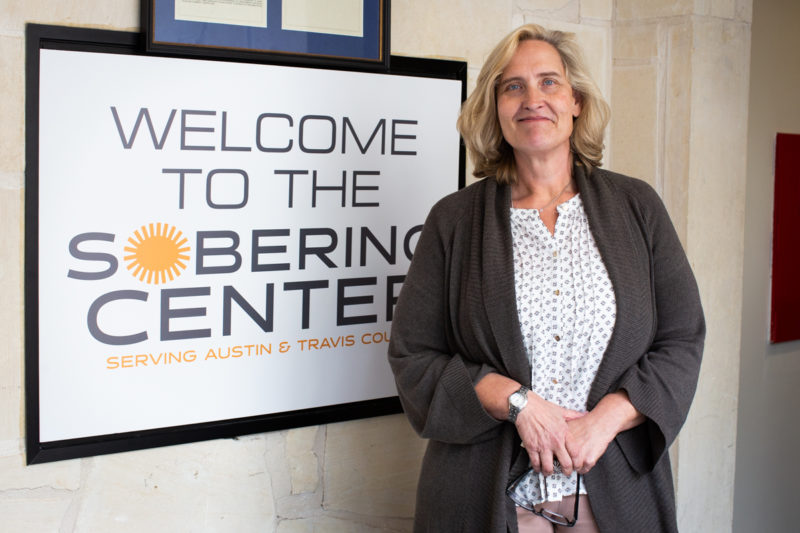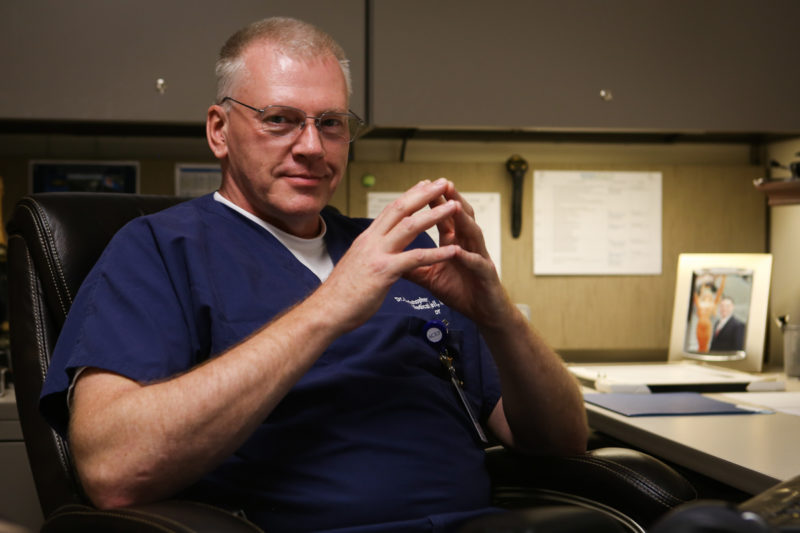Austin Sobering Center Saves Money and Lives, Officials Say
By Christopher De Los Santos
Reporting Texas

Dr. Rhonda Patrick, Executive Director of the Austin-Travis County Sobering Center. Pedro Luna/Reporting Texas.
Since the Austin-Travis County Sobering Center opened on Aug. 23, more then 500 intoxicated people have been treated at the center, which medical professionals and police say has freed up space in jails and emergency rooms and in the process has saved taxpayer money and perhaps even people’s lives.
“If a drunk turns rowdy in the ER and it takes six of my doctors and nurses to wrestle him down and sedate him, they aren’t then available to treat the heart attack or stroke patient in the next bed,” said Dell Seton Medical Center Emergency Director Christopher Ziebell. Because it can take six hours for an intoxicated patient to sober up enough to be released from the ER, the center has freed up hundreds of ER beds, Ziebell added.
The center, located at 1213 Sabine St. in downtown Austin, provides space for 8 women and 32 men to sober up. The center doesn’t admit people who are medically or psychiatrically unstable or people who were apprehended while committing a crime.
When EMS or law enforcement personnel bring someone to the facility, the person is quickly screened by a paramedic to determine if they meet admitting criteria. They have to be intoxicated enough to be a danger, but sober enough that they can consent to admission.
Staff then provide a bed and fluids to clients. Trained specialists supervise the intoxicated individuals and make sure they don’t choke on their own vomit or otherwise hurt themselves. Most clients stay for about five hours and never return.
“We have cut the number of public intoxication bookings into jail in half using the sobering center,” Austin Assistant Police Chief Justin Newsom said. Because it usually takes only 5 to 10 minutes to drop someone off at the center versus 1 to 3 hours to book someone into jail, officers covering Sixth Street on an average weekend can spend more time on patrol, he added.
Mark Escott, medical director for Austin-Travis County Emergency Medical Services, said the center has been a boon to emergency medical technicians.
“The sobering center allows my EMTs to hand intoxicated individuals off to officers and deputies for transport and then return their focus to treating individuals with acute medical needs and injuries,” Escott said.
The center is the third such facility to open in Texas. Houston opening a sobering center in 2013, and San Antonio followed in 2011. There are about two dozen centers nationwide.
In 2002, the city of Austin completed a sobering center feasibility study, but the push to build the center didn’t gain significant traction until a Formula One race weekend in October 2012. That weekend a temporary sobering center set up in a tent successfully served dozens of intoxicated people and caught the attention of community leaders, Ziebell said.

Dr. Christopher Ziebell, the medical director for the emergency department at Dell Seton Medical Center, was essential to providing medical care for intoxicated attendants at the 2012 United States Grand Prix Formula One race. The effort sparked a greater interest in a sobering center. Pedro Luna/Reporting Texas.
Prior attempts to develop a sobering center had stalled as commissioners and council members added other tasks in addition to sobering. City leaders wanted to add detoxification, outpatient treatment, residential treatment or a combination of these to the center’s role. These additional tasks pushed the cost too high, Ziebell said.
Travis County provides the building where the center is located, and the city of Austin has committed up to $1.7 million to fund the center’s annual operating budget.
Sobering Center Director Rhonda Patrick said that the center’s roll out has been smooth, with the exception of the University of Texas at Austin’s first home afternoon football game, which was played at on Sept. 22.
“That was the weekend we learned fans start drinking before noon when the Longhorns play home football at 3:30 p.m.,” Patrick said.
The center had its first patient that day at 4 p.m., about five hours earlier than most Saturdays, Patrick said. “We called in our sobering specialist early that day and she worked an extra-long shift. She really helped us and our patients.”
The center now brings in extra staff when the Longhorns play in the afternoon, Patrick said, and the staff is starting to learn when they will be busiest — on football games days, during music festivals and during Formula One races, for example.
The center’s goal for its first quarter in operation was to sober 500 people. Their goal for the first year is to sober 5,000, Patrick said.